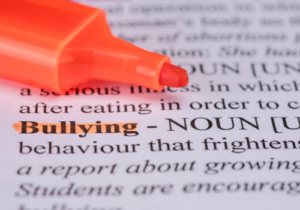BULLYING DEFINITIONS
BULLY versus BULLYING BEHAVIOR – At RESPECT we talk about people who USE bullying behavior rather than people who ARE bullies because we think it is important to separate the person from the behavior.
 In the same way you will see us do this on stage with other concerns, for example, a student may have a learning disability, but that is NOT who he or she IS. This helps us specifically address behaviors rather than label a person as a whole. We recognize that each person is a unique combination of experiences, strengths and weaknesses. We recognize that it is nearly always more successful to change a behavior in context rather than risk the harm that can come from labeling a person with a negative label that they may feel is so overwhelming that it is impossible to change. We think it is more positive and hopeful because we know bullying behaviors are learned and can be changed with support from all of us. And, finally, it is our experience that everyone – all of us – sometimes engage in bullying behaviors.
In the same way you will see us do this on stage with other concerns, for example, a student may have a learning disability, but that is NOT who he or she IS. This helps us specifically address behaviors rather than label a person as a whole. We recognize that each person is a unique combination of experiences, strengths and weaknesses. We recognize that it is nearly always more successful to change a behavior in context rather than risk the harm that can come from labeling a person with a negative label that they may feel is so overwhelming that it is impossible to change. We think it is more positive and hopeful because we know bullying behaviors are learned and can be changed with support from all of us. And, finally, it is our experience that everyone – all of us – sometimes engage in bullying behaviors.
» Physical Bullying
 This is any bullying that hurts someone’s body or damages their possessions. Stealing, shoving, hitting, fighting, and destroying property all are types of physical bullying. Physical bullying is rarely the first form of bullying that a target will experience. Often bullying will begin in a different form and progress to physical violence. In physical bullying the main weapon the bully uses is their body.
This is any bullying that hurts someone’s body or damages their possessions. Stealing, shoving, hitting, fighting, and destroying property all are types of physical bullying. Physical bullying is rarely the first form of bullying that a target will experience. Often bullying will begin in a different form and progress to physical violence. In physical bullying the main weapon the bully uses is their body.
Appropriate RESPECT Programs: Stop & Think, Fun & Games, Teaming Up, Between the Lines, Scraps, Reporting, Standing Up
» Verbal Bullying
 This is any bullying that is done by speaking. Calling names, spreading rumors, threatening somebody, and making fun of others are all forms of verbal bullying. Verbal bullying is one of the most common types of bullying. In verbal bullying the main weapon the bully uses is their voice.
This is any bullying that is done by speaking. Calling names, spreading rumors, threatening somebody, and making fun of others are all forms of verbal bullying. Verbal bullying is one of the most common types of bullying. In verbal bullying the main weapon the bully uses is their voice.
Appropriate RESPECT Programs: Stop & Think, Fun & Games, Teaming Up, Between the Lines, Scraps, Reporting, Standing Up
» Social Bullying/Relational Aggression
 This is any bully that is done with the intent to hurt somebody’s reputation or social standing. Social bullying often happens between friends. It can happen in two ways: either by trying to exclude somebody and make them feel unwanted, or by gaining somebody’s trust and then breaking it. Social bullying could include spreading a friend’s secret all over school to damage their reputation, or encouraging others to ignore, chastise, or threaten a friend. The movie Mean Girls (2004) shows many examples of this kind of bullying. This type of bullying is most common among girls, but can certainly happen with guys as well. In social bullying, the main weapons the bully uses are relationships.
This is any bully that is done with the intent to hurt somebody’s reputation or social standing. Social bullying often happens between friends. It can happen in two ways: either by trying to exclude somebody and make them feel unwanted, or by gaining somebody’s trust and then breaking it. Social bullying could include spreading a friend’s secret all over school to damage their reputation, or encouraging others to ignore, chastise, or threaten a friend. The movie Mean Girls (2004) shows many examples of this kind of bullying. This type of bullying is most common among girls, but can certainly happen with guys as well. In social bullying, the main weapons the bully uses are relationships.
Appropriate RESPECT Programs: Stop & Think, Fun & Games, Teaming Up, Between the Lines, Scraps, Reporting, Standing Up
» Cyberbullying
 This is any bullying that happens over any technological device. This includes email, instant messaging, social networking sites (such as Facebook), text messages, and cell phones. Cyberbullying is one of the trickiest forms of bullying because it is so new. Many adults are not familiar with the latest technology, making it difficult for them to know what to look for or how to intervene. The weapon the bully uses in cyberbullying is technology.
This is any bullying that happens over any technological device. This includes email, instant messaging, social networking sites (such as Facebook), text messages, and cell phones. Cyberbullying is one of the trickiest forms of bullying because it is so new. Many adults are not familiar with the latest technology, making it difficult for them to know what to look for or how to intervene. The weapon the bully uses in cyberbullying is technology.
Appropriate RESPECT Programs: Teaming Up, Between the Lines, Scraps, Reporting, Standing Up
» Dating Abuse
 Dating abuse is a type of bullying that can take the form of any type of bullying mentioned of above within the context of a dating relationship. Verbal, emotional, physical, or sexual abuse are all signs of an unhealthy relationship. An abusive relationship can be characterized by any one of those signs or a combination of many.
Dating abuse is a type of bullying that can take the form of any type of bullying mentioned of above within the context of a dating relationship. Verbal, emotional, physical, or sexual abuse are all signs of an unhealthy relationship. An abusive relationship can be characterized by any one of those signs or a combination of many.
Appropriate RESPECT Programs: Cracked But Not Broken
BULLIES, TARGETS, BYSTANDERS
» A Person Who Bullies
- Is the one who is trying to hurt or control others.
- Has often been bullied himself/herself.
- It is important to know that anybody can exhibit bullying behaviors!
» A Person Who Is Targeted
- Is the person who is being bullied.
- No one deserves to be bullied!
» Bystanders
- A bystander may or may not be a friend of the target, but he or she is aware that the bullying is happening.
- Bystanders can be leaders/heroes/role-models by doing something helpful or getting help! Bystanders can be silent bullies if they do not try to get help.
- A bystander can provide help by reporting the bullying. Reporting is not tattling! Tattling is trying to get someone into trouble. Reporting is trying to get someone out of trouble!
BULLYING SITUATIONS
» Unfair Use of Power
- Power can be defined in many ways (i.e., older, stronger, smarter, more friends in a given situation).
- Everyone needs power and control in their lives. However, people engaging in bullying behaviors use their power in unhealthy ways to hurt others.
- Ask: Were they using their power unfairly?
» Intent to Harm
- Sometimes accidents or misunderstandings can be misconstrued as bullying behaviors.
- Ask: Were they intentionally trying to hurt your feelings, body, or reputation?
» Repeated Behavior
- Sometimes people make mistakes and cross other peoples’ emotional and physical boundaries.
- Ask: Did you ask them to stop? Did you let them know that you did not like their behavior?
